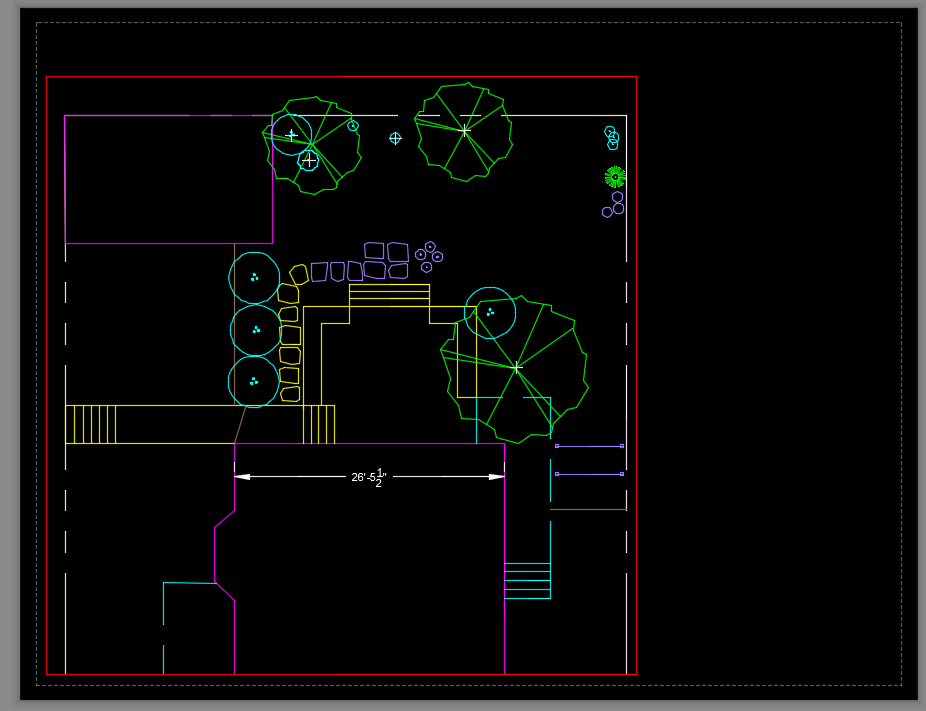
CAD discussion forum - ask any CAD-related questions here, share your CAD knowledge on AutoCAD, Inventor, Revit and other Autodesk software with your peers from all over the world. To start a new topic, choose an appropriate forum.
Please abide by the
rules of this forum.
This is a peer-to-peer forum. The forum doesn't replace the official direct technical support provided by ARKANCE for its customers.
How to post questions: register or login, go to the specific forum and click the NEW TOPIC button.
| Author |
 Topic Search Topic Search  Topic Options Topic Options
|
Biker Chick 
Newbie

Joined: 05.Sep.2015
Location: United States
Using: Autocad LT 2013
Status: Offline
Points: 9
|
 Topic: Dimensioning Topic: Dimensioning
Posted: 05.Oct.2015 at 19:09 |
|
Thank you Kent. That's exactly right. I may not have explained it clearly enough.
|
|
Patty Landscape Architect
|
 |
Kent Cooper 
Senior Member

Joined: 12.Mar.2013
Location: United States
Using: AutoCAD2020, 2023
Status: Offline
Points: 686
|
 Posted: 05.Oct.2015 at 18:46 Posted: 05.Oct.2015 at 18:46 |
 John Connor wrote: John Connor wrote:
You wrote, "I think the issue with Arch. vs Eng. units may be the base unit, not the
unit name. What I have found is that when I inherit a drawing by an
Architect it comes in 12 times the actual size and I have to scale it to
bring it into Engineering units."
I find that difficult to believe. A building that is 100 feet long is still going to be 100 feet long whether it is drawn in engineering units or architectural units in AutoCAD ....
|
No, it's not hard to believe at all -- it's perfectly logical, although I think the terminology may be getting confused here. I believe by "Engineering" units Biker Chick must be referring to typical Civil Engineering or Surveyor CAD-drafting practice, not to what AutoCAD calls "Engineering units" for length. In both Architectural and [AutoCAD's definition of] Engineering units, the drawing unit is an inch, which is the only way they can get feet and inches in Dimension text, allow them for user input, etc. -- the difference between them is only in portions of inches [fractions in Architectural, decimals in Engineering]. But Civil Engineers and Surveyors typically use a foot as a drawing unit, and use what AutoCAD calls Decimal units for length. A building that's 100 feet long is, in Architectural or [AutoCAD's] Engineering units, 1200 drawing units long. AutoCAD's drawing file format stores that size in "pure" drawing units, unaffected by what your Units settings are. When you import an Architect's drawing like that into a Civil Engineer's or Surveyor's drawing in which the drawing unit is a foot, it will still be 1200 drawing units long, which will come into that drawing as 1200 feet long, exactly as described, and it will need to be scaled down. We do this all the time, except in the other direction: we're Architects, so we scale up drawings we get from Civil Engineers, because their 100-foot building would be 100 drawing units long, which, unscaled, comes into our drawing as only 8'-4".
Edited by Kent Cooper - 05.Oct.2015 at 18:47
|
 |
John Connor 
Senior Member

Joined: 01.Feb.2011
Location: United States
Using: AutoCAD 2018
Status: Offline
Points: 7175
|
 Posted: 05.Oct.2015 at 11:51 Posted: 05.Oct.2015 at 11:51 |
|
You wrote, "I think the issue with Arch. vs Eng. units may be the base unit, not the
unit name. What I have found is that when I inherit a drawing by an
Architect it comes in 12 times the actual size and I have to scale it to
bring it into Engineering units."
I find that difficult to believe. A building that is 100 feet long is still going to be 100 feet long whether it is drawn in engineering units or architectural units in AutoCAD UNLESS someone, either you or the architect, is drawing "to scale" just as one might do if he/she were drafting the building manually on the board. Remember the days we had to "scale" a drawing to get it to fit on whatever paper size we were using (usually 24x36 or 22x34)?
Tell you what, the next time you get a drawing from an architect that exhibits this characteristic upload it to DropBox and post a link to it here. I'd like to take a look at one of them. Thanks.
Edited by John Connor - 05.Oct.2015 at 15:00
|
|
"Humans have a strength that cannot be measured. This is John Connor. If you are reading this, you are the resistance."
<<AutoCAD 2015>>
|
 |
John Connor 
Senior Member

Joined: 01.Feb.2011
Location: United States
Using: AutoCAD 2018
Status: Offline
Points: 7175
|
 Posted: 04.Oct.2015 at 23:57 Posted: 04.Oct.2015 at 23:57 |
|
You're welcomed. Glad to hear you got it all straightened out.
|
|
"Humans have a strength that cannot be measured. This is John Connor. If you are reading this, you are the resistance."
<<AutoCAD 2015>>
|
 |
Biker Chick 
Newbie

Joined: 05.Sep.2015
Location: United States
Using: Autocad LT 2013
Status: Offline
Points: 9
|
 Posted: 04.Oct.2015 at 23:55 Posted: 04.Oct.2015 at 23:55 |
|
|
|
Patty Landscape Architect
|
 |
Biker Chick 
Newbie

Joined: 05.Sep.2015
Location: United States
Using: Autocad LT 2013
Status: Offline
Points: 9
|
 Posted: 04.Oct.2015 at 23:28 Posted: 04.Oct.2015 at 23:28 |
|
Oh lordy. I figured it out. I inherited the base drawing from an architect and did not realize it was drawn in inches! Either that or I changed the units. Either way, it is not to scale as you said! I am so relieved. I thought I was crazy. I think the issue with Arch. vs Eng. units may be the base unit, not the unit name. What I have found is that when I inherit a drawing by an Architect it comes in 12 times the actual size and I have to scale it to bring it into Engineering units.
|
|
Patty Landscape Architect
|
 |
Biker Chick 
Newbie

Joined: 05.Sep.2015
Location: United States
Using: Autocad LT 2013
Status: Offline
Points: 9
|
 Posted: 04.Oct.2015 at 23:22 Posted: 04.Oct.2015 at 23:22 |
|
This is so odd. My files have the decimal units set to feet - I checked that because I thought it might be an issue. But when you receive them they are in inches! If they were in inches it would explain everything. I am stymied by what you say. When I bring up the Units dialogue box
|
|
Patty Landscape Architect
|
 |
John Connor 
Senior Member

Joined: 01.Feb.2011
Location: United States
Using: AutoCAD 2018
Status: Offline
Points: 7175
|
 Posted: 04.Oct.2015 at 01:04 Posted: 04.Oct.2015 at 01:04 |
Last thing for this evening. Here is what your basemap would look like in an 8.5x11 horizontal format at a scale of 1/8"=1'-0". The red box is my viewport. I created a new layer called Dims and added one dimension, in the layout, just to show you it can be done and that it is accurate. That's all for now. 
|
|
"Humans have a strength that cannot be measured. This is John Connor. If you are reading this, you are the resistance."
<<AutoCAD 2015>>
|
 |
John Connor 
Senior Member

Joined: 01.Feb.2011
Location: United States
Using: AutoCAD 2018
Status: Offline
Points: 7175
|
 Posted: 04.Oct.2015 at 00:27 Posted: 04.Oct.2015 at 00:27 |
|
I downloaded and opened both drawings and the first thing I did was check what you had Units set to. Guess what? Both are set to use the default of decimal inches. So, the reason why your dimensions are being displayed in inches is because that is what you are drawing in.
I measured the front of the house using the Distance command and got a value of 26.46 inches. I suspect that the true distance was supposed to be something closer to 26.46 feet (decimal feet and inches typically used in civil engineering). This would be expressed as 26'-5 1/2" in architectural units. As I said in my last post it is entirely possible to draw in engineering units yet dimension a drawing using architectural units.
This is what I would recommend.
1. Scale all the geometry in model space by a factor of 12.
2. Invoke the Units command and set the Type to Engineering and the Precision to 0'-0.0".
3. Create a new layer called VPort and assign a color other than white. Use this layer for your viewport in Layout1. Also, set this layer, to "no print" in the Layer Properties Manager. A red diagonal line will appear through the printer icon. The viewport will be visible on screen but it won't print.
Now I have a question. What scale do you want to use? Would you prefer an engineering scale like 1"=10' or an architectural scale like 1/8"=1'-0"? I see your siteplan has a scale of 1:8. This is actually a ratio not a commonly recognized or used scale, as far as I know, by architects or civil engineers.
4. Invoke the DimStyle command and set your Primary units to Architectural and Precision to 0'-0". Disable Zero Suppression for Inches and/or for Feet depending on your preferences.
5. Put your dimensions in your layout and not in model space.
6. Lock your viewport display so that you do not inadvertently change it.
Any questions?
Edited by John Connor - 04.Oct.2015 at 12:24
|
|
"Humans have a strength that cannot be measured. This is John Connor. If you are reading this, you are the resistance."
<<AutoCAD 2015>>
|
 |
Biker Chick 
Newbie

Joined: 05.Sep.2015
Location: United States
Using: Autocad LT 2013
Status: Offline
Points: 9
|
 Posted: 03.Oct.2015 at 20:59 Posted: 03.Oct.2015 at 20:59 |
PS I am a landscape architect, so most of my work is much more free-form! You may find the dimensioning plan a bit hard to fathom, but at least you can see my problem. 
|
|
Patty Landscape Architect
|
 |
 Discussion forum
Discussion forum CAD discussion forum - ask any CAD-related questions here, share your CAD knowledge on AutoCAD, Inventor, Revit and other Autodesk software with your peers from all over the world. To start a new topic, choose an appropriate forum.
CAD discussion forum - ask any CAD-related questions here, share your CAD knowledge on AutoCAD, Inventor, Revit and other Autodesk software with your peers from all over the world. To start a new topic, choose an appropriate forum.



![CAD Forum - tips, tricks, discussion and utilities for AutoCAD, Inventor, Revit and other Autodesk products [www.cadforum.cz] CAD Forum - tips, tricks, discussion and utilities for AutoCAD, Inventor, Revit and other Autodesk products [www.cadforum.cz]](/common/arkance_186.png)









 Dimensioning
Dimensioning
 Topic Options
Topic Options



 John Connor wrote:
John Connor wrote:




